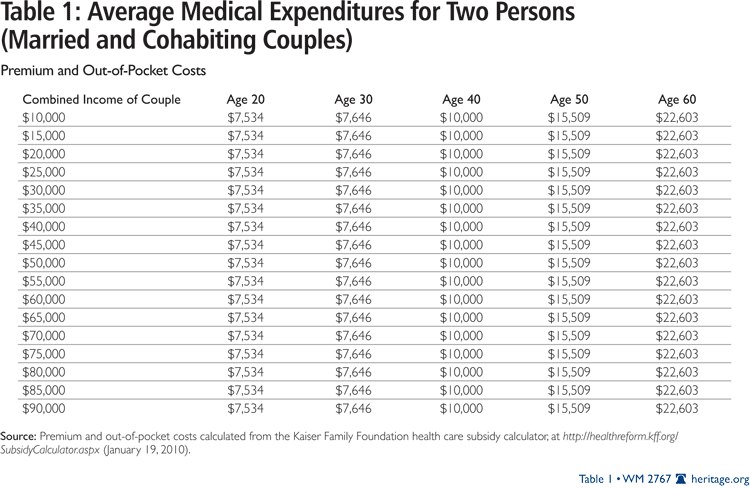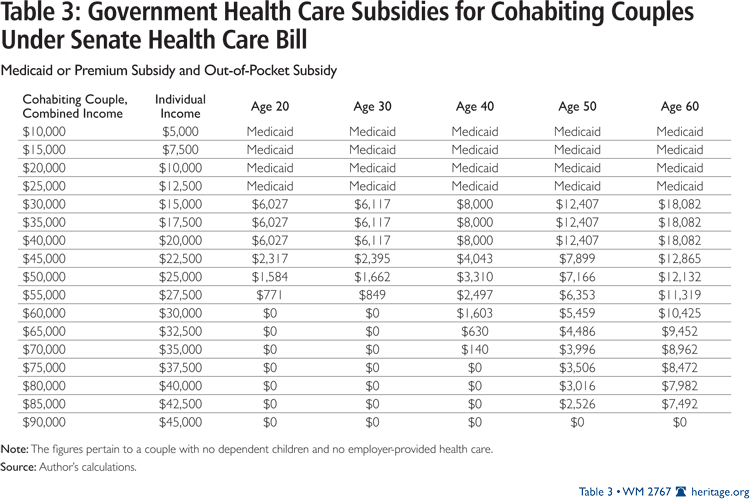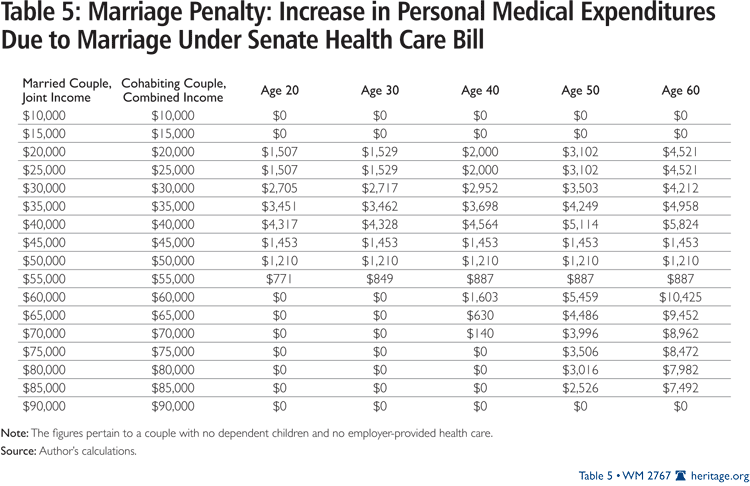One bizarre feature of the Senate-passed health care bill is its pervasive bias against marriage. Under the bill, couples would face massive financial penalties if they marry or remain married. Conversely, couples who cohabit without marriage are given highly preferential financial treatment. If the Senate bill becomes law, saying “I do” would cost some couples over $10,000 per year.[1]
Most people feel that marriage is a healthful institution that society should encourage and strengthen. Inexplicably, the Senate health care bill takes the opposite approach. At nearly all age and income levels, the bill profoundly discriminates against married couples, providing far less support to a husband and wife than to a cohabiting couple with the same income. If the bill is enacted, married couples across America will be taxed to provide discriminatory benefits to couples who cohabit, divorce, or never marry.
Analyzing Anti-Marriage Discrimination in the Senate Health Care Bill
The Senate bill is designed to provide health care benefits that are substantially more generous for lower-income persons. The bill’s anti-marriage penalties occur because of the income counting and benefit structure rules of the bill. If a two-earner couple is married, the bill counts their income jointly; since the joint income will be higher, a married couple’s health care subsidies would be lower.[2]
By contrast, if a couple cohabits rather than marrying, the bill counts each partner’s income separately. Separate counting means that, all else being equal, cohabiters would be treated as having lower incomes and therefore receive disproportionately greater government benefits. The bottom line: under the bill, a cohabiting couple would receive substantially higher health care subsidies than a married couple even when the total incomes of both couples are identical.
Tables 1 through 5 in the appendix illustrate this pattern of pervasive financial discrimination against married couples. In the examples in the charts, the couples are assumed to have no dependent children, neither partner has employer-provided health insurance, and each couple’s earned income is assumed to be split equally between the partners—if a married couple has an income of $50,000, the husband is assumed to earn $25,000 and the wife $25,000. (The details of the analysis are described in the appendix to this paper.)
As Tables 4 and 5 show, under the Senate bill, married couples in general would receive between $1,500 and $10,000 less in government health care support than would cohabiting couples with the same total income.
Government Bonuses for Refusing to Tie the Knot
The stiff anti-marriage penalties and heavy “cohabitation bonuses” built into the Senate Obamacare bill send a negative social message. In addition, the bill creates large incentives for couples to “game the system,” allowing and encouraging them to reap large financial rewards by living together rather than marrying.
For example, a young couple without children, age 20, each making $20,000, would receive $4,317 more in health benefits each year if they cohabit rather than marry. Slipping on the wedding ring would cut the couple’s annual disposable income by more than 10 percent. Rather than pay this new wedding tax, the couple is likely to postpone marriage or forego it entirely.
Penalizing Married Empty Nesters
Under the bill, the anti-marriage penalties increase sharply as a couple ages. The discriminatory anti-marriage penalties are particularly severe on middle-class “empty nester” couples. Many of those couples would pay an effective tax of $5,000 to $10,000 per year for the right to remain married.
For example, a 60-year-old couple, each earning $30,000 per year, would receive $10,425 per year less in benefits if they marry or remain married. Simply by divorcing and then living together, the couple can boost their post-tax, take-home income by nearly one-fourth.
Similarly, a 50-year-old couple, each earning $20,000 per year, would receive $5,114 less in benefits each year if they marry or remain married. By divorcing and then living together, the couple could increase its income by more than $50,000 over a decade.
Hammering Low-Income Married Couples
Low-income couples are not immune from the bill’s aggressive wedding taxes. A 60-year-old husband and wife, each with an income of $15,000, would pay over $4,000 per year if they remain married. Put in other terms, the government would offer an annual bonus of $4,212 if the couple divorces and then cohabits.
The Lifetime Marriage Tax
Annual penalties actually understate the depth of the anti-marriage bias in the Senate bill. The bill’s wedding tax is perpetual. Penalties against married couples add up year after year as long as the couple remains married. Some couples who remained married throughout their adult lives would face cumulative penalties of over $200,000 during the course of their marriage.
Defending the Indefensible
Proponents of the Senate health care bill might argue that these marriage penalties would reach their full effect only in situations where neither partner had employer-provided health insurance. It is true that married couples with employer coverage would face less bias; however, this defense of the bill remains weak because discrimination against marriage remains discrimination even if it does not fully affect all married couples. Such discrimination is unacceptable even in a single instance.
Moreover, the main purpose of the act is to provide health insurance to persons without employer-provided health insurance. The basic point here is that the new subsidy system designed to fulfill that purpose is highly discriminatory against married couples.
Finally, if Obamacare were enacted, the number of employers offering health insurance would decline over time.[3] Therefore, the number of married couples who would eventually lose employer-provided insurance—and face stark discrimination on the non-group market under the provisions of the Senate bill—would substantially increase in the long term.
Profound Bias Against Marriage
The Senate health care bill sends a clear message: Married couples are second-class citizens. On the other hand, the bill establishes cohabiters as a privileged special interest, quietly channeling tens of thousands of dollars to them in preferential government bonuses.
Offering couples massive financial rewards on the condition they jettison their wedding vows, or decline to make them in the first place, is absurd social policy. But that would be the established policy of the U.S. government if Obamacare becomes law.
Robert Rector is Senior Research Fellow in the Domestic Policy Studies Department at The Heritage Foundation.
Appendix: Analysis of Subsidy Differences

In the examples in the Tables 1 through 5, all couples are assumed to have no dependent children and have no employer-provided health insurance. Each married and unmarried couple’s earned income is assumed to be split equally between the partners; for example, if a married couple has an income of $50,000, the husband is assumed to earn $25,000 and the wife $25,000.
Table 1 shows the average health care costs for couples at different age levels. These costs include both insurance premiums, and out-of-pocket medical expenses. (See the methodological note for more information on these estimates.)

Table 2 shows the health care subsidies offered to each married couple under the Senate health care bill. The subsidies include Medicaid eligibility, insurance premium credits, and out-of-pocket health care expense credits as applicable.

Table 3 shows the health care support offered under the Senate bill to the same couples if the couple cohabits rather than marrying. Comparison of Tables 2 and 3 shows that cohabiting couples will receive substantially greater support from the government than similarly situated married couples.

Table 4 shows the difference in health care subsidies to be given to cohabiting couples and similarly situated married couples under the Senate bill. The figures were calculated by subtracting the subsidy figures in Table 2 for married couples from the corresponding figures for cohabiting couples in Table 3.

Table 5 calculates the marriage penalties by a different method. Government subsidies were subtracted from total medical costs (in Table 1) to determine a residual medical expense for each category. Residual medical expense represents the expenditures a couple must make from its own income to obtain medical care. Residual medical expenses for married couples were calculated by subtracting subsidies in Table 2 from total medical costs in Table 1. Residual medical expenses for cohabiting couples were calculated by subtracting subsidies in Table 3 from total medical costs in Table 1. The residual medical expenses for cohabiting couples were then subtracted from the residual medical expenses for married couples to produce the marriage penalty figures in Table 5. The marriage penalty figures in Tables 4 and 5 are the same: Both procedures yield the same estimates.
Methodological Note
The average total medical cost estimates by age in Table 1 were taken from the health care subsidy calculator at the Kaiser Family Foundation Web site.[4] The figures include both the cost of insurance premiums for a middle-tier plan and out-of-pocket expenses. Out-of-pocket expenses in accordance with the provisions of the Senate bill and the Kaiser model were set at 30 percent of total costs.
In Tables 2 and 3, Medicaid eligibility, premium credits, and out-of-pocket credits were calculated according to the provisions of the Senate-passed version of the Patient Protection and Affordable Care Act. The premium costs used in the calculations were taken from the Kaiser subsidy calculator, and they represent the costs for a middle-tier or “silver” insurance plan.
Cohabiting couples were assumed to purchase two individual insurance policies. Married couples were also assumed to buy two individual health care polices, since, under the provisions of the Senate bill, this option would generally be cheaper for them than purchasing a single family policy. This occurs because the Senate bill does not allow the cost of a family policy to vary by family size; if married couples without children were required to purchase a family policy without variation by family size, their premium costs would generally be greater than the cost of two individual policies. In consequence, if married couples were required to buy only family insurance policies, the extent of the penalties against marriage would be even greater than those shown in the present analysis.
Estimating the value of Medicaid benefits in Tables 4 and 5 is difficult. Medicaid offers recipients comprehensive coverage with minimal out-of-pocket expense. On the other hand, many contend that the actual quality of Medicaid service is low because some recipients have difficulty accessing care. Tables 4 and 5 assume that Medicaid recipients are slightly better off than individuals receiving the maximum value of premium credits and out-of-pocket credits, because the Medicaid recipients will have lower out-of-pocket costs. This assessment would be questionable if the quality of Medicaid service is, in fact, lower than care obtained with private insurance. However, this issue affects only families with combined income in the $20,000–$25,000 range. It does not significantly alter the overall analysis of discrimination against married couples.



